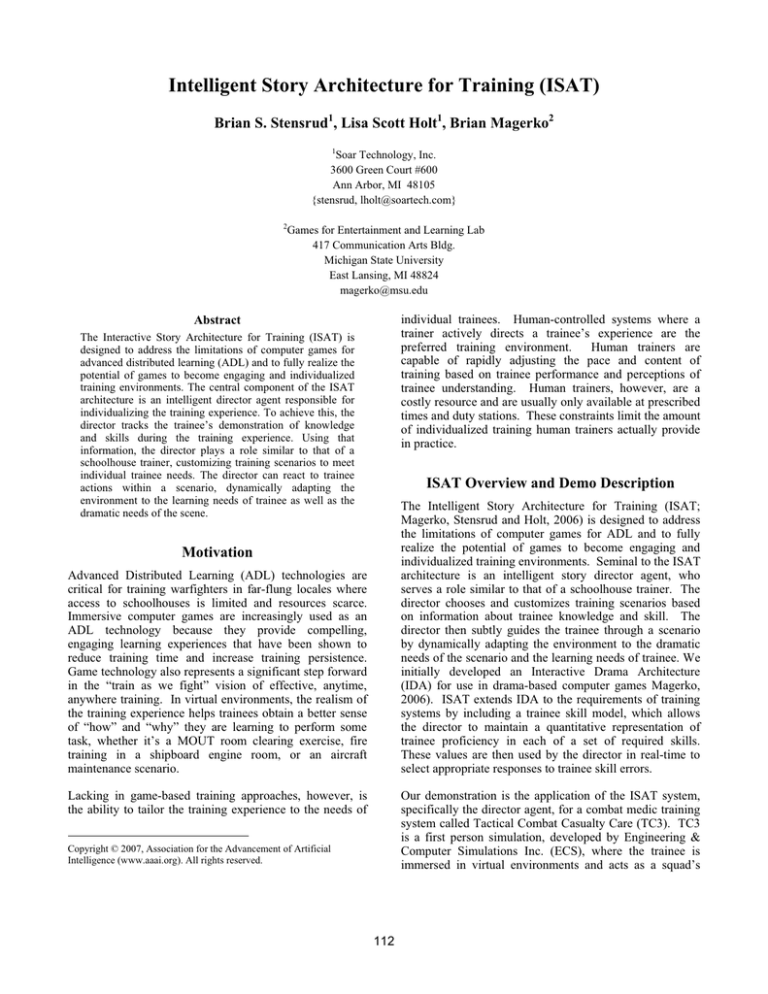
Intelligent Story Architecture for Training (ISAT)
Brian S. Stensrud1, Lisa Scott Holt1, Brian Magerko2
1
Soar Technology, Inc.
3600 Green Court #600
Ann Arbor, MI 48105
{stensrud, lholt@soartech.com}
2
Games for Entertainment and Learning Lab
417 Communication Arts Bldg.
Michigan State University
East Lansing, MI 48824
magerko@msu.edu
individual trainees. Human-controlled systems where a
trainer actively directs a trainee’s experience are the
preferred training environment.
Human trainers are
capable of rapidly adjusting the pace and content of
training based on trainee performance and perceptions of
trainee understanding. Human trainers, however, are a
costly resource and are usually only available at prescribed
times and duty stations. These constraints limit the amount
of individualized training human trainers actually provide
in practice.
Abstract
The Interactive Story Architecture for Training (ISAT) is
designed to address the limitations of computer games for
advanced distributed learning (ADL) and to fully realize the
potential of games to become engaging and individualized
training environments. The central component of the ISAT
architecture is an intelligent director agent responsible for
individualizing the training experience. To achieve this, the
director tracks the trainee’s demonstration of knowledge
and skills during the training experience. Using that
information, the director plays a role similar to that of a
schoolhouse trainer, customizing training scenarios to meet
individual trainee needs. The director can react to trainee
actions within a scenario, dynamically adapting the
environment to the learning needs of trainee as well as the
dramatic needs of the scene.
ISAT Overview and Demo Description
The Intelligent Story Architecture for Training (ISAT;
Magerko, Stensrud and Holt, 2006) is designed to address
the limitations of computer games for ADL and to fully
realize the potential of games to become engaging and
individualized training environments. Seminal to the ISAT
architecture is an intelligent story director agent, who
serves a role similar to that of a schoolhouse trainer. The
director chooses and customizes training scenarios based
on information about trainee knowledge and skill. The
director then subtly guides the trainee through a scenario
by dynamically adapting the environment to the dramatic
needs of the scenario and the learning needs of trainee. We
initially developed an Interactive Drama Architecture
(IDA) for use in drama-based computer games Magerko,
2006). ISAT extends IDA to the requirements of training
systems by including a trainee skill model, which allows
the director to maintain a quantitative representation of
trainee proficiency in each of a set of required skills.
These values are then used by the director in real-time to
select appropriate responses to trainee skill errors.
Motivation
Advanced Distributed Learning (ADL) technologies are
critical for training warfighters in far-flung locales where
access to schoolhouses is limited and resources scarce.
Immersive computer games are increasingly used as an
ADL technology because they provide compelling,
engaging learning experiences that have been shown to
reduce training time and increase training persistence.
Game technology also represents a significant step forward
in the “train as we fight” vision of effective, anytime,
anywhere training. In virtual environments, the realism of
the training experience helps trainees obtain a better sense
of “how” and “why” they are learning to perform some
task, whether it’s a MOUT room clearing exercise, fire
training in a shipboard engine room, or an aircraft
maintenance scenario.
Lacking in game-based training approaches, however, is
the ability to tailor the training experience to the needs of
Our demonstration is the application of the ISAT system,
specifically the director agent, for a combat medic training
system called Tactical Combat Casualty Care (TC3). TC3
is a first person simulation, developed by Engineering &
Computer Simulations Inc. (ECS), where the trainee is
immersed in virtual environments and acts as a squad’s
Copyright © 2007, Association for the Advancement of Artificial
Intelligence (www.aaai.org). All rights reserved.
112
combat medic. As such, the trainee must perform triage of
casualties, properly treat them, and also act as a soldier
within the squad. The ISAT director sits invisibly within
TC3 as the trainee executes a training scenario. During the
scenario, the director is responsible for:
Story Direction - managing the execution of each
scene within the simulation.
This includes
coordinating the behaviors of each of the NPCs in
the environment and all other scene-specific
events
Skill-Based Direction: Directing content within
each scene reactively based on the trainee’s
actions in the world (that are relevant to his
training objectives) and the current state of his
skill model
Reactive Direction: Directing content within
each scene reactively based on the trainee’s level
of engagement.
Scene Selection and Instantiation: Training
scenarios for the ISAT system are composed as a
collection of scenes. These scenes are then
selected and instantiated by the director according
to their dramatic and pedagogical relevance.
In our demonstration, the setting of the training scenario is
a Middle Eastern marketplace. As the view fades in, the
trainee’s squad has just taken several casualties from a
roadside IED explosion. The squad leader approaches the
trainee and informs him that the area is secure and that he
needs to begin treating casualties. This video includes
examples of story direction (through the execution of the
main plot thread), skill-based and reactive direction. The
video’s narration guides the viewer through the important
actions taking place and the ISAT director’s response to
those actions (if any).
References
Magerko, B. 2006: Player Modeling in the Interactive
Drama Architecture. Ph.D. Thesis, Electrical Engineering
and Computer Science Department, University of
Michigan, Ann Arbor, MI.
Magerko, B., Stensrud, B. and Holt, L.S. 2006: "Bringing
the Schoolhouse Inside the Box," Proceedings of the 25th
Army Science Conference, Orlando, FL.
113




